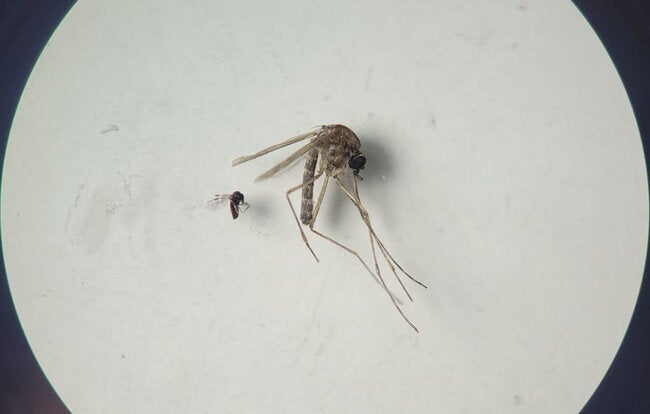Culicoides paraensis (smaller one in the photo) and Culex quinquefasciatus (larger one in the photo) || Photo: Bruna Lais Sena do Nascimento, Laboratório de Entomologia Médica/SEARB/IEC
Washington D.C., 24 July 2024 (PAHO) – In July this year, the Pan American Health Organization (PAHO) issued an epidemiological alert on an increase in reported cases of Oropouche virus (OROV) in five countries (Brazil, Bolivia, Peru, Cuba and Colombia) in the Region of the Americas.
We spoke to PAHO experts about this uptick in cases, recent reports on potential vertical transmission, and the Organization’s work to support affected countries as they continue to strengthen epidemiological surveillance.
What is Oropouche?
Oropouche (OROV) is an arbovirus and member of the Peribunyaviridae family. It was first detected in 1955 near the Oropouche River in Trinidad, followed by several utbreaks in Brazil towards the end of the last century. In 2024, over 7,700 OROV cases have been reported in five countries of the Americas: Brazil (6,976 cases by mid-2024), Bolivia, Peru, Cuba and Colombia (as of 23 July 2024).
How is it transmitted?
Oropouche is a vector-borne disease transmitted primarily through bites of an insect commonly known as a midge (Culicoides paraensis). It can also be transmitted by the mosquito Culex quinquefasciatus.
What is the clinical manifestation of Oropouche?
Symptoms include sudden onset of fever, headache, stiff joints, aches and pains and, in some cases photophobia, diplopia (double vision), nausea and persistent vomiting. Symptoms can last from five to seven days.
Rarely, severe cases can include aseptic meningitis. Full recovery can take several weeks.
Can people die from Oropouche?
Death from Oropouche is extremely rare. In 2024, there was one reported death (from meningitis) in Bahia and in 2023, there was one reported death (from meningitis) in Natal.
Can Oropouche be transmitted from expectant mother to unborn child?
Suspected cases of transmission from expectant mother to unborn child have been reported in recent weeks and are under investigation. A pregnant woman in Pernambuco, Brazil, presented symptoms of Oropouche during the 30th week of gestation. Following laboratory confirmation of the virus, fetal demise was reported. A second suspected instance was reported in the same state where similar symptoms were observed and resulted in a miscarriage. Possible vertical transmission and consequences in the fetus are still under investigation. PAHO issued an alert on 18 July to inform countries of this possible transmission and calling for increased surveillance.
Is this the first time there has been expectant mother to child transmission?
To date, Brazil is the only country to report possible cases of maternal to fetus transmission of Oropouche during pregnancy. The only previous similar observation was during an outbreak of Oropouche in Manaus between 1980 and 1981, where the virus was detected in nine pregnant women and two miscarried.
How is Oropouche diagnosed?
Oropouche is confirmed by laboratory test No rapid test currently exists.
What should I do if I think I may have Oropouche?
If you think you have symptoms of Oropouche, contact your health care worker for advice, testing and medical care.
Is there a treatment for Oropouche?
There is currently no specific treatment for Oropouche. Evaluation by a health care professional is key to the proper management of symptoms and disease evolution. As Oropouche has similar clinical manifestations in infected persons as dengue and other arboviruses, it is important that health care professionals consider differential diagnoses and treat patients accordingly.
How can I prevent Oropouche?
Recommended measures include protecting homes with fine mesh mosquito nets on doors and windows, as well as beds and furniture where people rest; wearing clothing that covers legs and arms; applying repellents containing DEET, IR3535 or icaridin. As midges are much smaller than mosquitoes, traditional mosquito nets will not protect against their bites.
Is there a risk of this becoming a larger outbreak?
While current outbreaks remain under investigation, PAHO has advised effected countries to strengthen surveillance and implement vector control measures to help prevent a further increase in cases.
If I’ve had Oropouche, can I get it again?
Four genotypes of Oropouche have been identified. Infection with any genotype will generate antibodies to protect against future reinfection.
Who is most at risk of disease?
Everyone living in areas with arbovirus transmission, including Oropouche, should take precautions to prevent mosquito and midge bites. This includes those with pre-existing conditions, the elderly, young children and pregnant women.
What does PAHO recommend for countries experiencing outbreaks?
PAHO calls on countries to implement vector prevention and control actions, including strengthening entomological surveillance, reducing mosquito populations (and other transmitting insects), and educating the population about personal protection measures.
PAHO has also issued guidelines to assist countries in the detection and surveillance of the Oropouche virus for possible cases of vertical infection, congenital malformation and death.
What is PAHO doing to tackle current outbreaks?
PAHO continues to provide ongoing technical support to affected countries to strengthen their capacity to detect and characterize the Oropouche virus. This includes the distribution of reagents for simultaneous molecular detection and a protocol that is currently available in 23 countries to facilitate early detection of the virus.
PAHO has also organized international workshops on the molecular surveillance of emerging and re-emerging arboviruses, including on OROV.
>>> Read full article>>>
Copyright for syndicated content belongs to the linked Source : WHO Americas – https://www.paho.org/en/news/24-7-2024-qa-oropouche-fever
